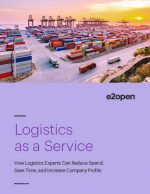Achieving End-to-End Visibility in Your Supply Chain
To run today’s supply chains requires a new paradigm, one that extends what ERP has done for the company within its four walls to the new reality of the multi-enterprise supply chain.
Companies are increasingly relying on a global network of suppliers, contract manufacturers, logistics providers, and other partners to design, assemble, ship, sell, and repair their products.
The trend to outsource activities that used to be performed in-house started in the high tech industry a few decades ago. Dell is probably the most well-known example of this transformation.
Other industries followed suit, attracted by both the ability to focus on their core competencies and the cost benefits of using specialized outsourcing partners.
Today, for example, most semiconductor companies are fabless, i.e., they design and market their chips but the manufacturing is performed in billion dollar “fabs” located in Asia. The same happened in the consumer goods industry: brand owners rely on co-packers, not only for small series where building dedicated plants is not costeffective, but increasingly for mainstream packaging and other manufacturing operations. It is a similar story in other industries as well. There is hardly a large company today that is not leveraging the benefits of outsourcing to some degree for manufacturing, assembly, logistics, or other operations.
Outsourcing has clearly paid off, with companies being able to offload non-core activities to specialized companies that could perform the work at a lower cost and, in many cases, do a better job at it. With globalization, the cost benefits of outsourcing became even more substantial as work could now be performed by offshore companies in lower wage countries.
It is important to note that outsourcing is about more than just reducing costs: It is tightly linked to the emergence of new business models. In the aerospace industry for example, companies used to be very vertically integrated.
Airbus and Boeing have both changed this setup and are increasingly relying on a worldwide network of partners that take over significant parts of the design and manufacturing. Some of these partners are true systems integrators, who assemble large parts of the planes – such as the cockpit – with the parts coming from multiple suppliers. The aircraft manufacturers can now focus on the final assembly.
On the distribution side, new fulfillment models are also emerging, such as “drop-ship.” What all these innovations have in common is the need for tight collaboration among multiple business partners, often globally distributed, and all independent companies.
What’s Related




Favorites





